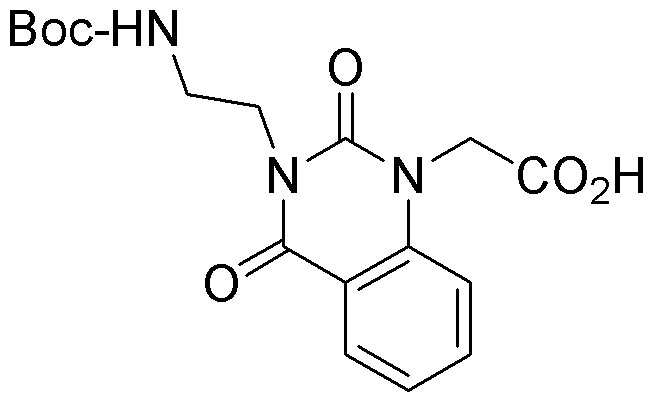Boc-3-(2-aminoethyl)-1-carboxymethylquinazoline-2,4-dione is widely utilized in research focused on:
- Drug Development: This compound serves as a key intermediate in synthesizing novel pharmaceuticals, particularly in the development of targeted cancer therapies due to its ability to interact with specific biological pathways.
- Biochemical Research: It is used in studies exploring enzyme inhibition and protein interactions, helping researchers understand complex biochemical processes and develop new therapeutic strategies.
- Material Science: The compound can be incorporated into polymer matrices, enhancing the properties of materials used in drug delivery systems, thus improving the efficacy and control of drug release.
- Diagnostics: Its unique structure allows for the development of diagnostic agents that can selectively bind to certain biomolecules, aiding in the early detection of diseases.
- Academic Research: Many academic institutions utilize this compound in various studies, providing a platform for students and researchers to explore its properties and applications in medicinal chemistry.
General Information
Properties
Safety and Regulations
Applications
Boc-3-(2-aminoethyl)-1-carboxymethylquinazoline-2,4-dione is widely utilized in research focused on:
- Drug Development: This compound serves as a key intermediate in synthesizing novel pharmaceuticals, particularly in the development of targeted cancer therapies due to its ability to interact with specific biological pathways.
- Biochemical Research: It is used in studies exploring enzyme inhibition and protein interactions, helping researchers understand complex biochemical processes and develop new therapeutic strategies.
- Material Science: The compound can be incorporated into polymer matrices, enhancing the properties of materials used in drug delivery systems, thus improving the efficacy and control of drug release.
- Diagnostics: Its unique structure allows for the development of diagnostic agents that can selectively bind to certain biomolecules, aiding in the early detection of diseases.
- Academic Research: Many academic institutions utilize this compound in various studies, providing a platform for students and researchers to explore its properties and applications in medicinal chemistry.
Documents
Safety Data Sheets (SDS)
The SDS provides comprehensive safety information on handling, storage, and disposal of the product.
Product Specification (PS)
The PS provides a comprehensive breakdown of the product’s properties, including chemical composition, physical state, purity, and storage requirements. It also details acceptable quality ranges and the product's intended applications.
Certificates of Analysis (COA)
Search for Certificates of Analysis (COA) by entering the products Lot Number. Lot and Batch Numbers can be found on a product’s label following the words ‘Lot’ or ‘Batch’.
*Catalog Number
*Lot Number
Certificates Of Origin (COO)
This COO confirms the country where the product was manufactured, and also details the materials and components used in it and whether it is derived from natural, synthetic, or other specific sources. This certificate may be required for customs, trade, and regulatory compliance.
*Catalog Number
*Lot Number
Safety Data Sheets (SDS)
The SDS provides comprehensive safety information on handling, storage, and disposal of the product.
DownloadProduct Specification (PS)
The PS provides a comprehensive breakdown of the product’s properties, including chemical composition, physical state, purity, and storage requirements. It also details acceptable quality ranges and the product's intended applications.
DownloadCertificates of Analysis (COA)
Search for Certificates of Analysis (COA) by entering the products Lot Number. Lot and Batch Numbers can be found on a product’s label following the words ‘Lot’ or ‘Batch’.
*Catalog Number
*Lot Number
Certificates Of Origin (COO)
This COO confirms the country where the product was manufactured, and also details the materials and components used in it and whether it is derived from natural, synthetic, or other specific sources. This certificate may be required for customs, trade, and regulatory compliance.


